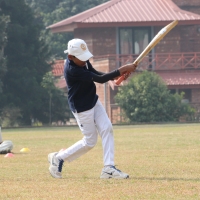|
 Do you think cricketing talent is fixed or something that grows? Do you think cricketing talent is fixed or something that grows?
Your answer will make a difference to your ambitions as a cricketer. You answer will determine how, when and if you get the "once chance" that you deserve.
According to research by Stanford Professor of Psychology, Carol S. Dweck, we all start with the view that ability is either ingrained and set from birth, or it can be nurtured and grown like a delicate flower. Nobody knows for sure which is true, but we all lean one way or the other.
So what has this got to do with your once chance to become a cricketer?
Let's pick an example.
The career of the "fixed mindset" player
Dinesh is a young bowler from India. He loves cricket, plays games and often does well against his peers. His bowling his fast and his hitting is hard.
He also has a "fixed mindset" and believes his natural talent is set, and cannot be developed. He knows he is a good player though, so he has no fear because when his chance comes along he will make the most of it.
So, he waits.
One of these days, he will be spotted by a top coach or player. His obvious natural talent will be seen. He will be given a trial at a professional Academy. He will score runs and take wickets. All he needs is that one precious chance to show off his talent. IPL glory awaits.
Perhaps even playing for India!
He ignores challenges that will not get him his chance, and sees no need to put in any extra effort or learn anything new. His coach is not a good coach and all he does is criticise. Dinesh doesn't need that. He is talented, he is ready, he is one step from success.
After some time, he gets frustrated. His chance has not come and he is stuck.
He suspects that local administrators and coaches are favouring lesser talented players above him for corrupt reasons. He starts looking on the internet for somewhere to give him the chance he needs. He posts, emails and messages people in the hope he gets that chance to prove what he knows is true.
Still the chance does not come knocking.
Then his parents sit down with him and tell him the dream is over. No matter how good a player he is, he must study hard and build a real career. He knows that cricket is in his heart, but reality is in the way. He gives up the game and begins his studies in earnest.
What went wrong?
The problem for Dinesh is the same for many young players around the world: a fixed mindset.
On the surface you may say that coaches, parents and those blind to Dinesh's skills were to blame. As Dinesh is a made up player we can say for sure that he had buckets of skill. In fact, it wasn't skill, or lack of chances, it was his mindset.
Dinesh believed he was a natural talent, and that was all he needed to succeed.
People with a fixed mindset like this tend to:
- See failure as a negative to be avoided
- See success as proof of their natural talent
- Avoid challenges because it leads to failure
- Give up easily when a problem arises as it is proof of limitation
- See effort as pointless as it gets you nowhere
- See criticism of skill as personal attacks
- Are threatened by the success of others
Players with this mindset tend to "sit in" on their talent, make little effort to improve and get stuck. Dinesh is a classic example and even gave up the game, as many real players have, when confronted with the problem of choosing a career.
Taking control and making chances
What, then, is the alternative?
Let's go back to Dinesh and switch his mindset to "growth". Those with a growth mindset believe skill can be developed.
Now, instead of waiting for one chance, Dinesh goes about making his ambition a reality through hard work.
He takes up every challenges he can find, no matter how small. He realises each one is a chance to learn. He puts in effort with extra nets, reading about the latest methods and fitness training. His coach provides valubel feedback that Dinesh is keen to listen to, process and try.
Dinesh thinks that often local administrators and coaches are favouring lesser talented players above him for corrupt reasons. He is inspired by the success of lesser players, and those better than him, and redoubles his efforts to improve knowing that every run and every wicket make it harder to be ignored.
As a result, Dinesh reaches ever higher levels of achievement.
Far beyond anything he could have reached by relying on natural talent alone.
Then his parents sit down with him and tell him the dream is over. No matter how good a player he is, he must study hard and build a real career. He knows that cricket is in his heart, so he works out a way to manage both until he knows which way is going to lead to a career.
This Dinesh had a desire to learn, like all those with the growth mindset he:
- Embraces challenges as a way to learn
- Sees failure as a chance to learn what is wrong, and therefore be closer to what works
- Believes in his heart that the harder you work, the faster you master the game
- Sees criticism as a chance to learn.
Which mindset to you think is more likely to succeed?
A fixed mindset can be damaging because it relies much more on factors out of your control. If you have this mindset, you are far more likely to be begging for your "one chance" because you believe you have already done all you can. That may work, and I'm sure it has for many players. But it's not your best chance.
So, when you are looking to become a cricketer, start with your mindset. Is it working for you? Can you do more to develop your skill and make your chances rather than assuming they will come if you have enough talent?
Discuss this article with other subscribers
|

.jpg)




.jpg)


